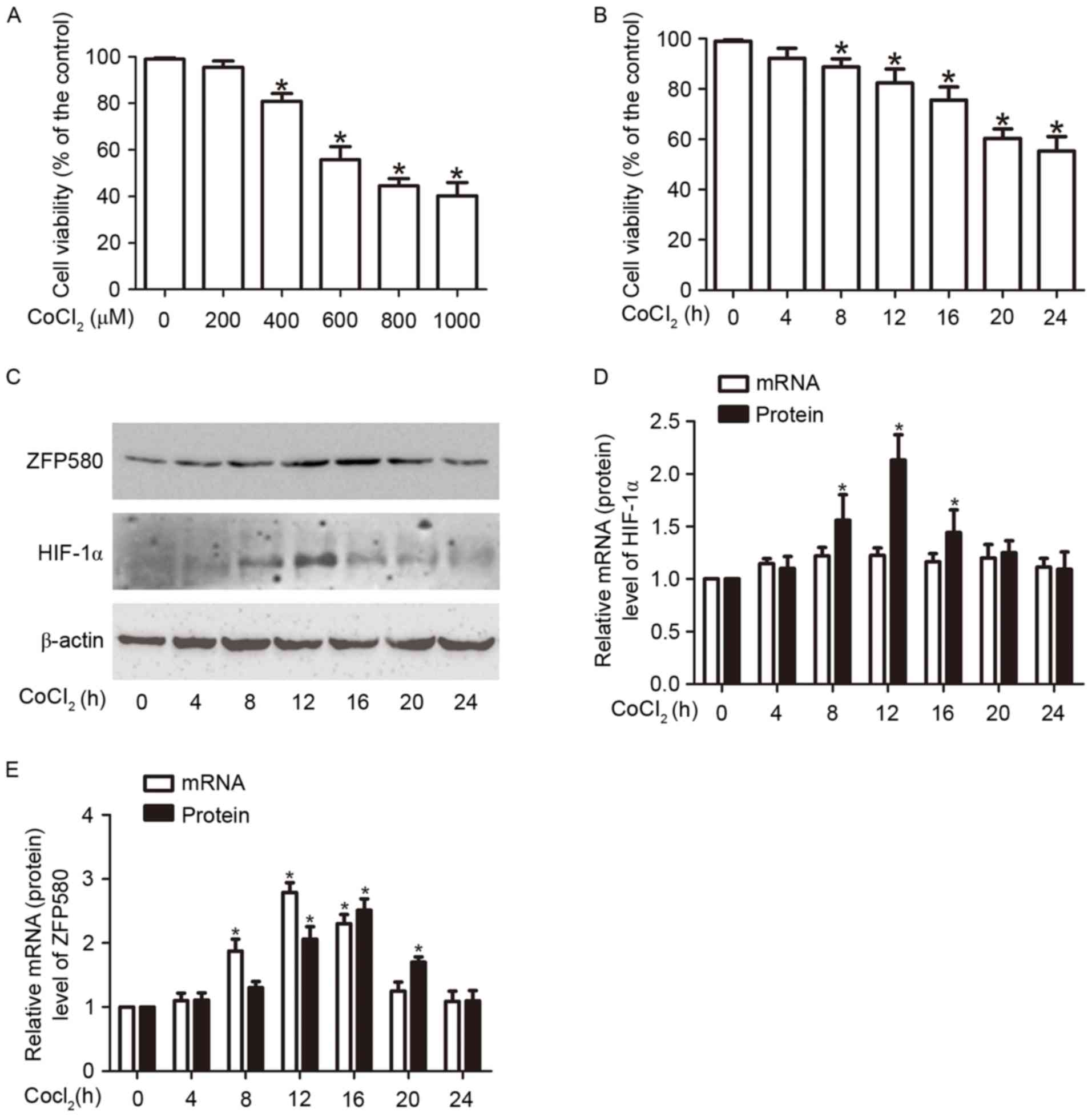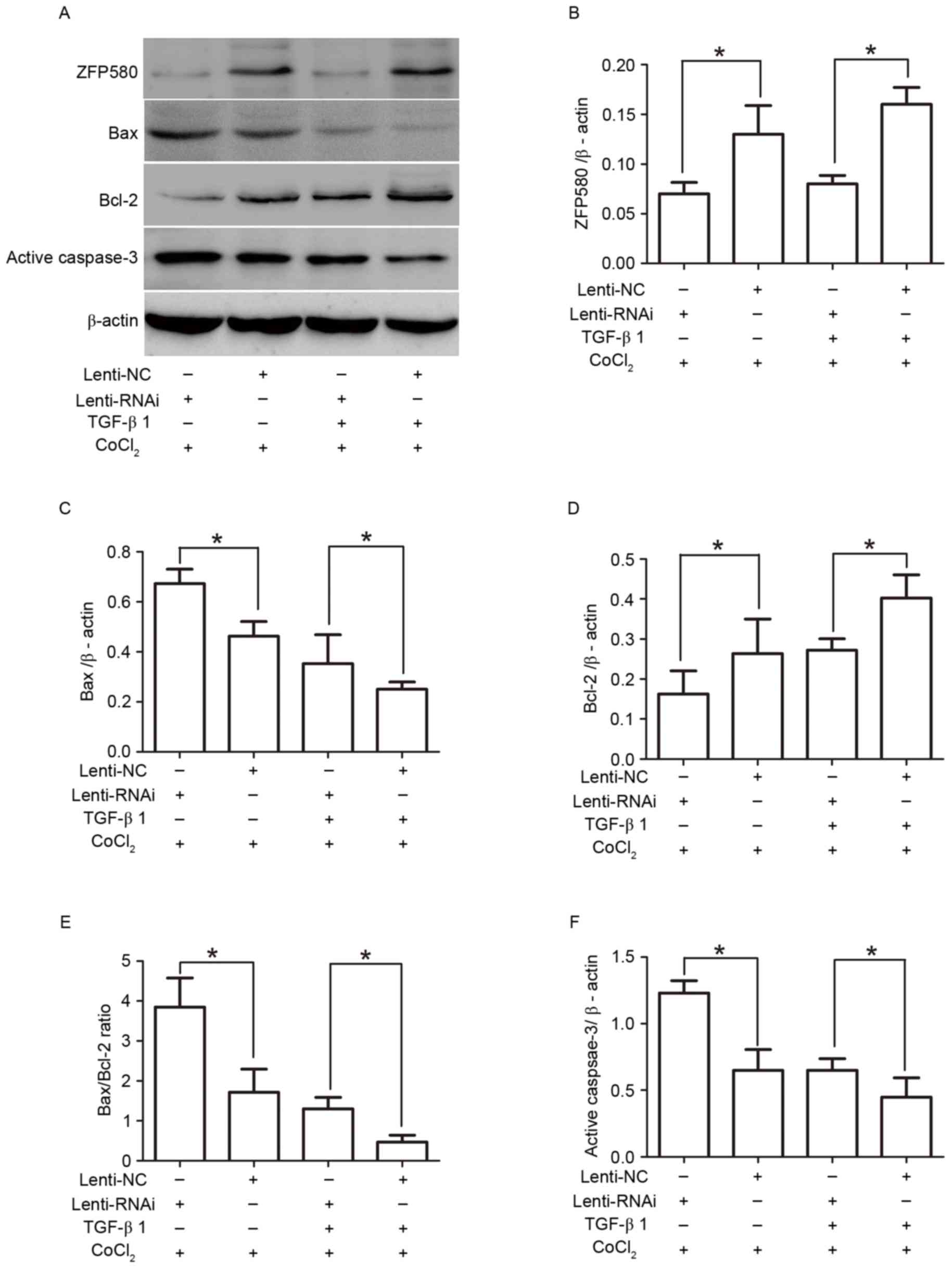|
1
|
Zhang WC, Chen BS, Zeng WW and Wu G:
Cloning and tissue expression of a novel gene down-regulated by low
density lipoprotein. Basic Med Sci Clin. 23:279–282. 2003.
|
|
2
|
Zhang WC, Sun HY and Luo YY: Construction
of eukaryotic expression vector for ZNF580 and EGFP fusion protein
and its expression and localization in HEK293 cells. Acta Acad Med
CPAF. 17:161–165. 2008.
|
|
3
|
Thomas JH and Emerson RO: Evolution of
C2H2-zinc finger genes revisited. BMC Evol Biol. 9:512009.
View Article : Google Scholar : PubMed/NCBI
|
|
4
|
DangLi R, HeKong W, JiQin L, MingHua Z and
WenCheng Z: ROS-induced ZNF580 expression: A key role for
H2O2/NF-κB signaling pathway in vascular endothelial inflammation.
Mol Cell Biochem. 359:183–191. 2012. View Article : Google Scholar : PubMed/NCBI
|
|
5
|
Sun HY, Wei SP, Xu RC, Xu PX and Zhang WC:
Sphingosine-1-phosphate induces human endothelial VEGF and MMP-2
production via transcription factor ZNF580: Novel insights into
angiogenesis. Biochem Biophys Res Commun. 395:361–366. 2010.
View Article : Google Scholar : PubMed/NCBI
|
|
6
|
Zhu Y and Zhang W: Cloning and analyzing
of the cDNA sequence of N-terminal region and C-terminal region of
zinc finger protein (ZFP580) gene. Life Science Journal. 5:68–73.
2008.
|
|
7
|
Meng XY, Yu HL, Zhang WC, Wang TH, Mai X,
Liu HT and Xu RC: ZFP580, a novel zinc-finger transcription factor,
is involved in cardioprotection of intermittent high-altitude
hypoxia against myocardial ischemia-reperfusion injury. PLoS One.
9:e946352014. View Article : Google Scholar : PubMed/NCBI
|
|
8
|
Chen H, Li D, Saldeen T and Mehta JL:
TGF-beta 1 attenuates myocardial ischemia-reperfusion injury via
inhibition of upregulation of MMP-1. Am J Physiol Heart Circ
Physiol. 284:H1612–H1617. 2003. View Article : Google Scholar : PubMed/NCBI
|
|
9
|
Dandapat A, Hu CP, Li D, Liu Y, Chen H,
Hermonat PL and Mehta JL: Overexpression of TGFbeta1 by
adeno-associated virus type-2 vector protects myocardium from
ischemia-reperfusion injury. Gene Ther. 15:415–423. 2008.
View Article : Google Scholar : PubMed/NCBI
|
|
10
|
Frantz S, Hu K, Adamek A, Wolf J, Sallam
A, Maier SK, Lonning S, Ling H, Ertl G and Bauersachs J:
Transforming growth factor beta inhibition increases mortality and
left ventricular dilatation after myocardial infarction. Basic Res
Cardiol. 103:485–492. 2008. View Article : Google Scholar : PubMed/NCBI
|
|
11
|
Al-Azayzih A, Gao F, Goc A and Somanath
PR: TGFβ1 induces apoptosis in invasive prostate cancer and bladder
cancer cells via Akt-independent, p38 MAPK and JNK/SAPK-mediated
activation of caspases. Biochem Biophys Res Commun. 427:165–170.
2012. View Article : Google Scholar : PubMed/NCBI
|
|
12
|
Fu MY, He YJ, Lv X, Liu ZH, Shen Y, Ye GR,
Deng YM and Shu JC: Transforming growth factor-β1 reduces apoptosis
via autophagy activation in hepatic stellate cells. Mol Med Rep.
10:1282–1288. 2014.PubMed/NCBI
|
|
13
|
Sánchez-Capelo A: Dual role for TGF-beta1
in apoptosis. Cytokine Growth Factor Rev. 16:15–34. 2005.
View Article : Google Scholar : PubMed/NCBI
|
|
14
|
Baxter GF, Mocanu MM, Brar BK, Latchman DS
and Yellon DM: Cardioprotective effects of transforming growth
factor-beta1 during early reoxygenation or reperfusion are mediated
by p42/p44 MAPK. J Cardiovasc Pharmacol. 38:930–939. 2001.
View Article : Google Scholar : PubMed/NCBI
|
|
15
|
Yang BC, Zander DS and Mehta JL:
Hypoxia-reoxygenation- induced apoptosis in cultured adult rat
myocytes and the protective effect of platelets and transforming
growth factor-beta(1). J Pharmacol Exp Ther. 291:733–738.
1999.PubMed/NCBI
|
|
16
|
Luo Y, Zhao Y, Li X, Zhao J and Zhang W:
ZNF580 mediates eNOS expression and endothelial cell
migration/proliferation via the TGF-β1/ALK5/Smad2 pathway. Mol Cell
Biochem. 393:199–207. 2014. View Article : Google Scholar : PubMed/NCBI
|
|
17
|
Luo Y, Hu W, Xu R, Hou B, Zhang L and
Zhang W: ZNF580, a novel C2H2 zinc-finger transcription factor,
interacts with the TGF-β signal molecule Smad2. Cell Biol Int.
35:1153–1157. 2011. View Article : Google Scholar : PubMed/NCBI
|
|
18
|
Tong XX, Wu D, Wang X, Chen HL, Chen JX,
Wang XX, Wang XL, Gan L, Guo ZY, Shi GX, et al: Ghrelin protects
against cobalt chloride-induced hypoxic injury in cardiac H9c2
cells by inhibiting oxidative stress and inducing autophagy.
Peptides. 38:217–227. 2012. View Article : Google Scholar : PubMed/NCBI
|
|
19
|
Livak KJ and Schmittgen TD: Analysis of
relative gene expression data using real-time quantification PCR
and the 2(−Delta Delta C(T)) method. Methods. 25:402–408. 2001.
View Article : Google Scholar : PubMed/NCBI
|
|
20
|
Chen SL, Yang CT, Yang ZL, Guo RX, Meng
JL, Cui Y, Lan AP, Chen PX and Feng JQ: Hydrogen sulphide protects
H9c2 cells against chemical hypoxia-induced injury. Clin Exp
Pharmacol Physiol. 37:316–321. 2010. View Article : Google Scholar : PubMed/NCBI
|
|
21
|
Yuan Y, Hilliard G, Ferguson T and
Millhorn DE: Cobalt inhibits the interaction between
hypoxia-inducible factor-alpha and von Hippel-Lindau protein by
direct binding to hypoxia-inducible factor-alpha. J Biol Chem.
278:15911–15916. 2003. View Article : Google Scholar : PubMed/NCBI
|
|
22
|
Wang K, Lei J, Zou J, Xiao H, Chen A, Liu
X, Liu Y, Jiang L, Xiao Z and Xiao X: Mipu1, a novel direct target
gene, is involved in hypoxia inducible factor 1-mediated
cytoprotection. PLoS One. 8:e828272013. View Article : Google Scholar : PubMed/NCBI
|
|
23
|
Mehta JL, Chen HJ and Li DY: Protection of
myocytes from hypoxia-reoxygenation injury by nitric oxide is
mediated by modulation of transforming growth factor-beta1.
Circulation. 105:2206–2211. 2002. View Article : Google Scholar : PubMed/NCBI
|
|
24
|
Wang F, Chen L, Ni H, Wang G, Ding W, Cong
H, Ju S, Yang S and Wang H: APRIL depletion induces cell cycle
arrest and apoptosis through blocking TGF-β1/ERK signaling pathway
in human colorectal cancer cells. Mol Cell Biochem. 383:179–189.
2013. View Article : Google Scholar : PubMed/NCBI
|
|
25
|
Vivar R, Humeres C, Ayala P, Olmedo I,
Catalán M, García L, Lavandero S and Díaz-Araya G: TGF-β1 prevents
simulated ischemia/reperfusion-induced cardiac fibroblast apoptosis
by activation of both canonical and non-canonical signaling
pathways. Biochim Biophys Acta. 1832:754–762. 2013. View Article : Google Scholar : PubMed/NCBI
|
|
26
|
Li HX, Han M, Bernier M, Zheng B, Sun SG,
Su M, Zhang R, Fu JR and Wen JK: Kruppel-like factor 4 promotes
differentiation by transforming growth factor-beta
receptor-mediated Smad and p38 MAPK signaling in vascular smooth
muscle cells. J Biol Chem. 285:17846–17856. 2010. View Article : Google Scholar : PubMed/NCBI
|
|
27
|
Lan A, Liao X, Mo L, Yang C, Yang Z, Wang
X, Hu F, Chen P, Feng J, Zheng D and Xiao L: Hydrogen sulfide
protects against chemical hypoxia-induced injury by inhibiting
ROS-activated ERK1/2 and p38MAPK signaling pathways in PC12 cells.
PLoS One. 6:e259212011. View Article : Google Scholar : PubMed/NCBI
|
|
28
|
Wang Z, Liao SG, He Y, Li J, Zhong RF, He
X, Liu Y, Xiao TT, Lan YY, Long QD and Wang YL: Protective effects
of fractions from Pseudostellaria heterophylla against cobalt
chloride-induced hypoxic injury in H9c2 cell. J Ethnopharmacol.
147:540–545. 2013. View Article : Google Scholar : PubMed/NCBI
|
|
29
|
Jung JY, Mo HC, Yang KH, Jeong YJ, Yoo HG,
Choi NK, Oh WM, Oh HK, Kim SH, Lee JH, et al: Inhibition by
epigallocatechin gallate of CoCl2-induced apoptosis in rat PC12
cells. Life Sci. 80:1355–1363. 2007. View Article : Google Scholar : PubMed/NCBI
|
|
30
|
Tan CY, Ban H, Kim YH and Lee SK: The heat
shock protein 27 (Hsp27) operates predominantly by blocking the
mitochondrial-independent/extrinsic pathway of cellular apoptosis.
Mol Cells. 27:533–538. 2009. View Article : Google Scholar : PubMed/NCBI
|
|
31
|
Bakhshayesh M, Zaker F, Hashemi M, Katebi
M and Solaimani M: TGF-β1-mediated apoptosis associated with
SMAD-dependent mitochondrial Bcl-2 expression. Clin Lymphoma
Myeloma Leuk. 12:138–143. 2012. View Article : Google Scholar : PubMed/NCBI
|
|
32
|
Surachetpong S, Jiranantasak T,
Rungsipipat A and Orton EC: Apoptosis and abundance of Bcl-2 family
and transforming growth factor β1 signaling proteins in canine
myxomatous mitral valves. J Vet Cardiol. 15:171–180. 2013.
View Article : Google Scholar : PubMed/NCBI
|














